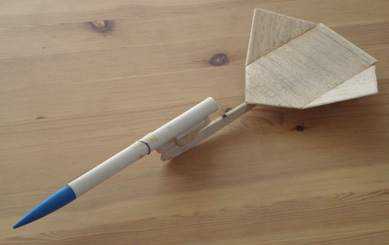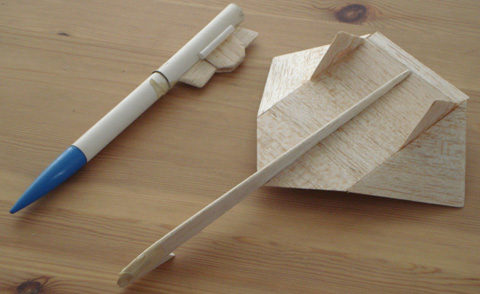Competition Model Rockets Mini-Manta
Competition Model Rockets Mini-Manta
Contributed by Todd Mullin
| Construction Rating: | starstarstarstarstar_border |
| Flight Rating: | starstarstarstarstar_border |
| Overall Rating: | starstarstarstarstar_border |
 Brief:
Brief:
Not long ago, I decided to try and get DART to start hosting NAR competition flying again. After some discussion, it
was decided that one of the events we would try out would be A boost glider. In my search for a design that would be
competitive, I had this one recommended. The CMR Mini-Manta is a delta wing, competition ready boost glider. Although
it is long out of production, the three pages of plans and templates can be downloaded from
Ye Olde Rocket
Plans in PDF format.
Construction:
While the plans don't call out the parts in nice, easy Estes part numbers, there isn't much that can go wrong if a
you have even one boost glider under your belt before trying this little gem.
The plans use a BT-5 tube for the body tube, even though in CMR numbers it is called out as a RB-50. The plans also ask for an elliptical, balsa nose. I substituted a plastic parabolic cone because I like to use a slightly heavier but more aerodynamic cone on my pop pods. The plans require a 3"x7"x1/16" for the wings and tails, a piece of 1/8"x1"x10" balsa for the body and pod stand off and a couple small pieces of 1/64" plywood. As I didn't have any 1/64" plywood laying around, I substituted some of the 1/16" balsa for the alignment plates. An engine block, a bit of shock cord and a streamer round out the supplies that you will need. The instructions were quite easy to follow. The illustrations were more than adequate to build the Mini-manta.
Construction begins with the pop pod. Not much real contruction there though. Attach the nose to the shock cord, streamer and then to the body tube. As I have had issues with getting streamers out of BT-5 tubes before, I chose to put my Kevlar® shock cord on the outside of the tube. The other bonus of this is zippers are practically impossible!
The wing and fin templates were scans of the actual balsa pieces. Not a lot of parts on this one, so not much to go wrong as long as you pay attention to the direction of the grain of the wood. I was a bit concerned about the sturdiness of the wings as they are only 1/16" balsa but as long as you stay within the recommended power range, you should be okay.
The wings are glued together and then adhered to the body. The tail fins on this model go down, opposite from the direction of the dihedral of the wings. Personally, I think the glider would look amazing if it flew upside down, but the laws of aerodynamics just work better if it flies right side up.
A small notch is cut from the main body and sandwiched between the alignment plates as the anchor for the glider during boost.
Pretty basic and straight forward if you have built a boost glider kit before. I however wouldn't recommend trying the Mini-manta for your first one though.
Finishing:
As with all competition class gliders, weight is your enemy. I did no finishing on this rocket other than to give it
a good sanding with a high grit sandpaper. The Mini-manta could be given a bit of color with markers or covered with
monokote or tissue. The instructions do say that if you plan to fly it with motors larger than those recommended to
cover the wings.
The main challenge in finishing a glider is trimming it to fly properly, and the Mini-manta is a quirky challenge. I trimmed the glider by tossing it in my closed up garage. I got what I thought was a reasonable glide out of it finally by adding just a touch of nose weight.
Construction Rating: 4 out of 5
 Flight:
Flight:
The instructions recommended using either 1/4A3-2T, 1/2A3-2T or A3-2T motors. Unfortunately, the A3-2T is no longer
in production, so I swapped out the A3-4T instead as I needed a full A motor for the competition.
I prepped the pop pod by putting a couple of pinches of dog barf wadding in and tightly rolling up the streamer and inserting it. I inserted the motor and masking taped it in place as there is no motor hook. After loading the pod onto the launcher, I hooked the glider on.
The Mini-manta boosted quite nicely, with only a slight arc. The extra couple of seconds on the delay probably helped get some more altitude because I had used the slightly heavier nose cone. The ejection charge fired and the glider released perfectly. The glide however, was less than optimal. It stalled every couple of seconds and the overall flight was pretty disappointing.
It seems that the speed of flight of the Mini-Manta is different than the test tosses that I had made. It needed additional nose weight for the actual flights. I had used brads from my nail gun as nose weight, so I could tightly control the exact nose weight. I took off the two brads on the nose and added a strip of four. Four seemed to be the correct amount based on the new test tosses done with a much harder throw.
The second launch was about the same boost profile as the first. This time however, the glider flew MUCH better!
Recovery:
I have made several additional flights with this glider and I am impressed with the amount of flight time I get on
nearly every flight. If launched in unstable air though, the glider tends to rock side to side and it tends to loose
altitude much faster.
After as many flight as I have made, I am starting to see a slight bit of charring on the top of the glider body where the motor sits. If it gets much worse, I might add a small piece of aluminum foil at that point.
Flight Rating: 4 out of 5
Summary:
Overall, the CMR Mini-manta is a fun little boost glider. I particularly like it's delta wing styling that sets it
apart from the standard front wing design that is commonly seen in competition gliders. It's cheap and easy to build,
so even if you loose the glider or the pod, it's not a huge hit to the pocket book and it won't take you a month to
build another one. The Mini-manta is a reliable flier, with most of my flights easily exceeding a minute now that the
glider is properly trimmed.
The Mini-manta could easily be build for a 18mm pop pod as well, though the power of the larger motors may force the flier to make the glider heavier by adding covering to withstand the additional strain of boost.
Overall Rating: 4 out of 5
 |
 |